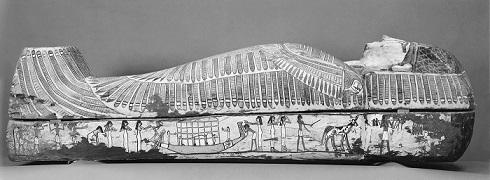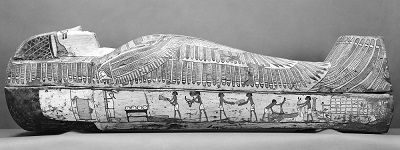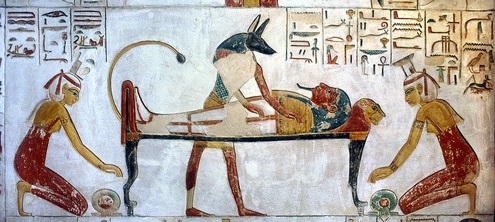When looking at the decoration of some rishi coffins from Ancient Egypt we notice that many of them follow similar rules:
- On both sides of the coffin base there are the funerary ceremony practices, which can include the common mourners shaking their hair and sometimes the two professional mourners in the role of Isis and Nephtys accompanying the corpse.

The two mourners in the role of Isis and Nephtys at the feet of the lid in a rishi coffin. British Museum. XVIII Dynasty. Photo: www.britishmuseum.org
- At the feet of the lid in the frontal extreme the coffin usually the two professional mourners, who are the representatives of Isis and Nephtys (Drty), appear kneeling over the neb hieroglyph making mourning gestures or holding the shenu hieroglyph, as we can see in this rishi coffin from the British Museum.
The distribution of these images in the coffin was not accidental, but something deliberate. Why?
The exterior of the coffin base had images of the Egyptian funeral, that is, the practices which took place on earth, as the mourning ritual and the nwn gesture of shaking hair made by the common mourners. We are facing here the earthly dimension; this decoration shows what happens on Earth for the deceased’s resurrection. That is the reason why the artist put these scenes on the exterior side of the lowest part of the coffin.

Rishi coffin. Right side with the funerary procession. XVII-XVIII Dynasty. Thebes. Photo: www.metmuseum.org
In some cases the two Drty appear standing at both extremes of the corpse, but in a static way. They do not shake or pull their hair as we know they did in the professional mourning ritual. Why? Because the rites they did for granting the mummy’s regeneration did not belong to the earthly sphere, but were closer to the divine one.

The two mourners at the feet of the lid in a rishi coffin. XVII-XVIII Dynasty. Metropolitan Museum of Art of New York. Photo: www.metmuseum.org
The two Drty appear at the feet of the coffin, but on the exterior side of the lid, so an upper level. They are here the two representatives of Isis and Nephtys. Two human women performing as goddesses, they are carrying out the divine rites for bringing the dead back to life, so they are at the threshold of the divine dimension.
Summing up, it seems to exist a place for each mourner and for each mourning ritual in a rishi coffin. In the lower part the common mourners were lamenting on earth; at the feet of the lid the two mourners in the role of Isis and Nephtys did their mourning rites reproducing at the gates of the Afterlife the Osiris myth for bringing the dead back to life.
But that is not all…
To be continued…










